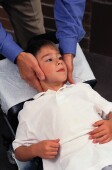
SATURDAY, May 18 (HealthDay News) — Children who swallow high-powered magnets often need surgery and other invasive procedures to remove the objects, according to a new study.
The researchers, from the Louisiana State University Health Center in New Orleans, found that more than 79 percent of children who swallowed very strong “neodymium magnets” required either surgery or an endoscopic procedure, in which a tube containing a camera is inserted into the digestive tract. Only 21 percent of these cases can be treated through observation or by pumping the stomach, they said.
These magnets may appear harmless, but they are up to 20 times stronger than typical refrigerator magnets and are powerful enough to cause significant — even fatal — damage to the digestive tract.
Although many ingested objects pass through a child’s system without serious problems, children frequently swallow more than one neodymium magnet at a time, the researchers said. As a result, the magnets can pull together and perforate the intestinal wall.
“We seemed to be seeing more and more of these cases, some of which were very serious — even life-threatening,” Dr. Robert Adam Noel, associate professor of pediatrics at Louisiana State University Children’s Hospital, said in a news release from the Digestive Disease Week annual meeting. “Our research not only confirms our concern, but also shows that early intervention is particularly important with these magnet ingestions.”
In conducting the study, the researchers questioned pediatric gastroenterologists across the United States and tracked the medical and surgical procedures used to treat patients who swallowed neodymium magnets.
The study found that in 31 percent of cases, surgery alone was needed to remove the ingested magnets. In 43 percent of the surgical cases, however, a second invasive procedure was required.
“The findings send a strong message to clinicians and parents,” Noel said. “Although they look harmless on an X-ray, these magnets are powerful enough to cause serious damage to the digestive tract in a short amount of time.”
Although children between 13 months and 6 years old are at greatest risk for swallowing neodymium magnets, older children’s risk is increasing because the magnets are used for body jewelry and fake piercings.
The study is scheduled for presentation Saturday at the Digestive Disease Week meeting in Orlando. Data and conclusions of studies presented at medical meetings should be considered preliminary until published in a peer-reviewed journal.
More information
The American Academy of Pediatrics has more about the dangers of magnet ingestion.

